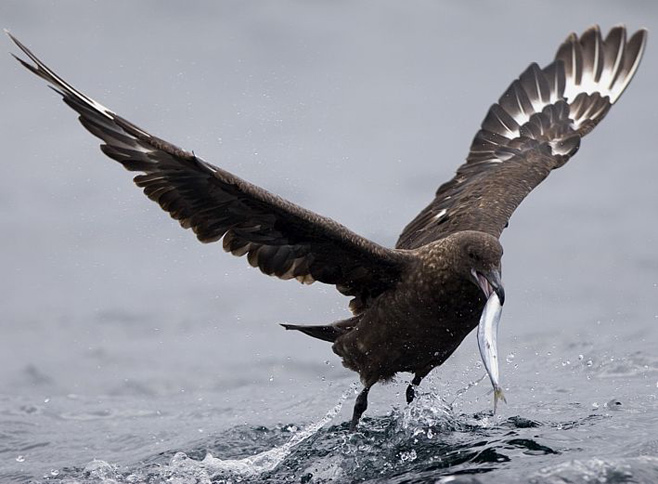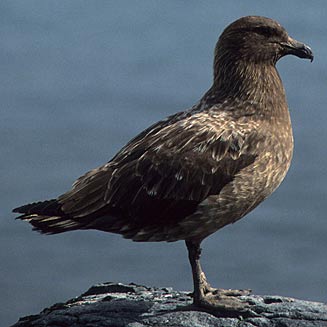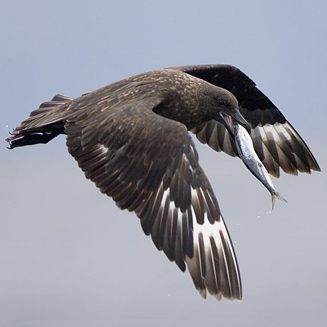|
Catharacta antarctica
(Subantarctic skua)
Bruinroofmeeu [Afrikaans]; Subantarctische …. [Dutch];
Labbe antarctique [French]; Skua [German]; Moleiro-subantárctico
[Portuguese]
Life
> Eukaryotes >
Opisthokonta
> Metazoa (animals) >
Bilateria >
Deuterostomia > Chordata >
Craniata > Vertebrata (vertebrates) > Gnathostomata (jawed
vertebrates) > Teleostomi (teleost fish) > Osteichthyes (bony fish) > Class:
Sarcopterygii (lobe-finned
fish) > Stegocephalia (terrestrial
vertebrates) > Tetrapoda
(four-legged vertebrates) > Reptiliomorpha > Amniota >
Reptilia (reptiles) >
Romeriida > Diapsida > Archosauromorpha > Archosauria >
Dinosauria
(dinosaurs) > Saurischia > Theropoda (bipedal predatory dinosaurs) >
Coelurosauria > Maniraptora > Aves
(birds) > Order: Charadriiformes
> Family: Laridae > Genus: Catharacta
 |
|
Subantarctic skua catching fish, pelagic trip off
of Cape Town, South Africa. [photo Trevor Hardaker ©] |
 |
 |
|
Subantarctic skua. [photo Peter Steyn
©] |
Subantarctic skua with caught fish, pelagic trip
off of Cape Town, South Africa. [photo Trevor Hardaker ©] |
Distribution and habitat
Breeds at the Antarctic Peninsula, southern South America
and sub-Antarctic islands, dispersing across the southern oceans including
southern African waters. Here it is fairly common of the southern and western
coasts of the region, while absent off Mozambique.
Predators and parasites
Strangely enough it is sometimes killed by its own prey, as
an 18cm cuttlefish was once recorded to eat through the bird's stomach lining
and body wall, which caused the bird's death. It is also a host of protozoan
parasites and susceptible to avian cholera.
Movements and migrations
It is resident at some breeding sites and
migratory at others, although present year-round in southern African
waters, with numbers peaking in winter. This coincides with the influx of
post-breeding adults and juveniles from Marion and Crozet Island.
Food
It mainly eats fish and large aquatic invertebrates, doing
most of its foraging by grabbing prey from the water surface or stealing food
from other birds. It is a regular forager around fishing vessels and often
predates the nests of burrowing petrels at their colonies. The following food items have been recorded
in its diet:
- Vertebrates
- fish
- Merluccius (hake)
- Scomberesox saurus (Sauries)
- Engraulis encrasicolus (Anchovies)
- Maurilocus muelleri (Lightfishes)
- birds
- invertebrates
- squid
- crustaceans
- Lepas (goose barnacles)
- molluscs
- seabirds
- carrion
Threats
Not threatened.
References
-
Hockey PAR, Dean WRJ and Ryan PG 2005. Roberts
- Birds of southern Africa, VIIth ed. The Trustees of the John Voelcker
Bird Book Fund, Cape Town.
|
